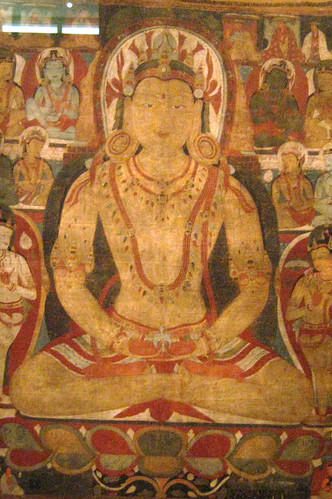
NYC - Metropolitan Museum of Art - The Buddha Amitayus Attended by Bodhisattvas, originalmente cargada por wallyg.
The Buddha Amitayus attended by bodhisattvas
Tibet, 11th century
Distemper on cloth
The cult of Amitayus, the Buddha of Eternal Life, was extremely popular in Tibet, as his followers believed that devotion to this Buddha would prolong their lives. Amitayus is shown cradling a jar containing the elixir of immortality in his lap as he preaches to an assemblage of Bodhisattvas (beings who have reached enlightenment but remain earthbound to save mankind) in his heaven. He is flanked by two Bodhisattvas standing on a gentle tribhanga (thrice-bent posture) typical of Indian Art and two tiers of seated Bodhisattvas, all of whom receive his doctrine. The seven figures in the upper register may be Buddhist hierarchs; they wear long-sleeved undergarments, voluminous cloaks, and flat hats, characteristics of eleventh-century Tibetan costume. At the bottom left are two figures, probably the donors of the painting, and on the right is a monk in monastic costume, who possiblly consecrated the thanka (painting on cloth). The monumental volumes of the deities and the slightly naïve rendering of the subsidiary figures are typical of this early phase of Tibetan thankas.
Rogers Fund, 1989 (1989.284)
**
The Metropolitan Museum of Art's permanent collection contains more than two million works of art from around the world. It opened its doors on February 20, 1872, housed in a building located at 681 Fifth Avenue in New York City. Under their guidance of John Taylor Johnston and George Palmer Putnam, the Met's holdings, initially consisting of a Roman stone sarcophagus and 174 mostly European paintings, quickly outgrew the available space. In 1873, occasioned by the Met's purchase of the Cesnola Collection of Cypriot antiquities, the museum decamped from Fifth Avenue and took up residence at the Douglas Mansion on West 14th Street. However, these new accommodations were temporary; after negotiations with the city of New York, the Met acquired land on the east side of Central Park, where it built its permanent home, a red-brick Gothic Revival stone "mausoleum" designed by American architects Calvert Vaux and Jacob Wrey Mold. As of 2006, the Met measures almost a quarter mile long and occupies more than two million square feet, more than 20 times the size of the original 1880 building.
In 2007, the Metropolitan Museum of Art was ranked #17 on the AIA 150 America's Favorite Architecture list.
The Metropolitan Museum of Art was designated a landmark by the New York City Landmarks Preservation Commission in 1967. The interior was designated in 1977.
Rogers Fund, 1989 (1989.284)
**
The Metropolitan Museum of Art's permanent collection contains more than two million works of art from around the world. It opened its doors on February 20, 1872, housed in a building located at 681 Fifth Avenue in New York City. Under their guidance of John Taylor Johnston and George Palmer Putnam, the Met's holdings, initially consisting of a Roman stone sarcophagus and 174 mostly European paintings, quickly outgrew the available space. In 1873, occasioned by the Met's purchase of the Cesnola Collection of Cypriot antiquities, the museum decamped from Fifth Avenue and took up residence at the Douglas Mansion on West 14th Street. However, these new accommodations were temporary; after negotiations with the city of New York, the Met acquired land on the east side of Central Park, where it built its permanent home, a red-brick Gothic Revival stone "mausoleum" designed by American architects Calvert Vaux and Jacob Wrey Mold. As of 2006, the Met measures almost a quarter mile long and occupies more than two million square feet, more than 20 times the size of the original 1880 building.
In 2007, the Metropolitan Museum of Art was ranked #17 on the AIA 150 America's Favorite Architecture list.
The Metropolitan Museum of Art was designated a landmark by the New York City Landmarks Preservation Commission in 1967. The interior was designated in 1977.













No hay comentarios:
Publicar un comentario